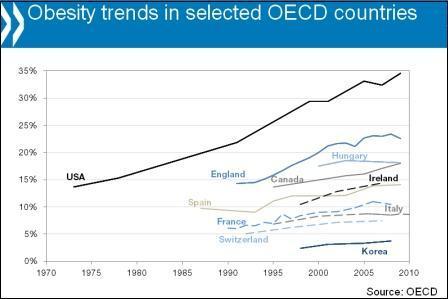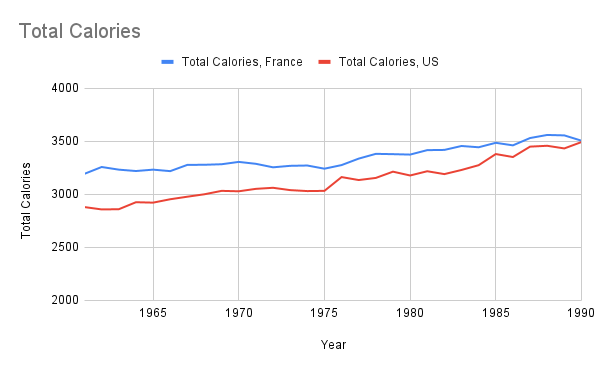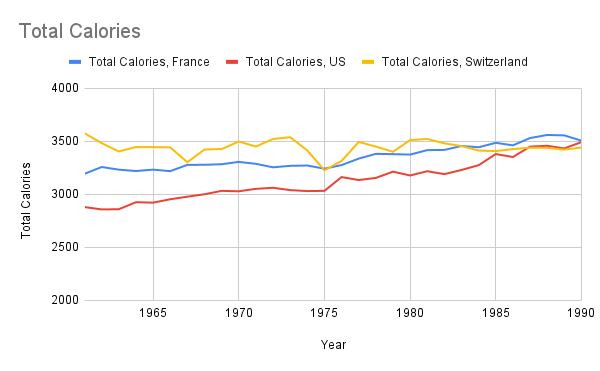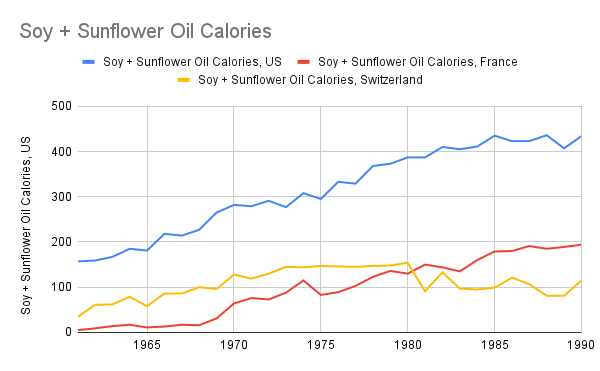I’ve recently had several run-ins with people who believe strictly in the calories-in, calories-out hypothesis of obesity. I just read Herman Pontzer’s book Burn, so I’ll continue to pick on him for the moment.
In Pontzer’s estimation, humans are just calorie-burning machines. Slightly complicated machines, but machines nonetheless. We have a more or less fixed metabolic rate that can’t be increased but which can be decreased with caloric restriction. We cannot increase total calories burned by exercising because the body compensates by, for instance, spending less energy on immune function. Therefore, the only way to stay lean is to limit calories-in.
The reason that the obesity epidemic started is because we live in an obesogenic environment where we are surrounded by highly palatable food options which overwhelm the pleasure centers of the hypothalamus. Our brains are simply overwhelmed with pleasure, we overeat, calories-in exceed calories-out and we become fat.
The theory is very logical but a problem with it is that it utterly fails to explain the events of the 20th century.
The French Paradox
The French diet is unapologetically rich in butter, cheese, sausages, baguettes, croissants, chocolate, bonbons, etc. This sounds like an obesogenic environment to me, and yet the obesity epidemic in France lagged decades behind the one in the US. When I point this out, people are quick to respond with these three arguments::
- The French walk a lot.
- The French don’t snack.
- The French eat small portions.
Pontzer’s own research suggests that point 1 – the French are more physically active – probably does not have a lot to do with French leanness. The real trick is points 2 and 3. By eating small portions and not snacking, the French are actually managing to achieve a reduction in calories-in compared to Americans.
Nutritionists will tell you at length how hard it is to get an accurate assessment of how many calories an individual has eaten unless you literally follow them around with a kitchen scale, weighing every morsel. Calories are usually estimated from Food Frequency Questionaires where people write down everything they ate in the last 24 hours. People tend to underestimate portion sizes, they forget about that late night snack, etc.
Because of this, the data set that I prefer about calories consumed on a national level is economic in nature. It is called “food disappearance” or “food balance”. National governments keep fairly exact records of how much wheat flour, milk, white sugar, potatoes, etc are produced in the country, imported and exported. The difference between the expected inventories (production + imports – exports) and actual inventories is food “disappearance”. All that food was either wasted or eaten. If we make the presumption that wealthy industrial countries waste similar amounts of food, this gives us a pretty good estimate of which countries ate more food than others.

The obesity epidemic was well on its way in the US by 1990, but had barely started in France. The FAOSTAT country by country food balance data goes back to 1961. So it’s fairly trivial to ask if points 2 and 3 are actually true? Did the French eat less than Americans in the 30 year period when the obesity epidemic was exploding in America. The answer is absolutely not! The french “disappeared” an additional 214 calories per day per person during this time. This means that a 50 year old living in America in 1990 would be four times as likely to be obese as a French person despite being responsible for disappearing 2.4 MILLION less calories between the ages of 20 and 50.

If you look at the chart of obesity rates, the only European country that had significantly fewer obese adults in the 90s was Switzerland. The Swiss diet combines the tastiest eating traditions of France – baguettes and gruyere – with those of Germany – wiener schnitzel and bratwurst – and adds its own specialties like fondue. Despite the highly palatable cuisine, certainly the Swiss are paragons of moderation? They must’ve eaten less calories to be this lean, at least compared to the gluttonous French. Let’s layer them onto the chart.

During the decade from 1961-1970 the average Swiss person disappeared a whopping 500 more calories PER DAY than the average American. The same 50 year old Swiss person in 1990 would have disappeared a whopping 3.4 million more calories over the last 30 years than the American and would be 5 times less likely to be obese.
Do you remember the Swiss bread riots of the 60s and 70s, when the Swiss were burning baguettes in the streets? You don’t because they didn’t happen. The Swiss probably ate those baguettes.
If the French and Swiss ate far more calories than Americans yet remained leaner, there are really only three options.
- They burned off the huge caloric excess through physical activity. Based on Pontzer’s work this seems unlikely.
- They have high metabolic rates due to inflammation. I can’t imagine why the entire populations of France and Switzerland would be particularly more inflamed than those of Americans.
- They have higher basal metabolic rates. It seems like this has to be the answer, but why.
The ROS Theory of Obesity
In the ROS Theory of Obesity, I argue that saturated fat drives mitochondrial ROS production which is a thermogenic loop that regenerates NAD+. I have further argued that linoleic acid is converted to Oxidized Linoleic Acid Metabolites (OXLAMs) by cytochrome P450 enzymes that are triggered by the Aryl Hydrocarbon Receptor which have the long term effect of increasing lipogenic genes including SCD1, which unsaturates your body fat. Burning unsaturated fat lowers your metabolic rate.
Let’s look at the consumption over time of the two main polyunsaturated fats (PUFA) consumed in the US, France and Switzerland from 1961-1990: soybean and sunflower oil. The ROS Theory of Obesity would predict that a rise in PUFA consumption would be the trigger causing obesity rather than a rise in calories. Once people begin to gain weight, calories will go up because larger bodies burn more calories. You can see calories rising in France and the US from 1975 and 1990. But even in 1990 they’re still only eating the amount of calories that the Swiss always ate, so it’s hard to argue that the rise in obesity in America was caused by the rising calories. Furthermore, since the Americans were fatter, even in 1990 – as calories between France, Switzerland and the US reached parity – the French and Swiss were still eating more calories per lb of fat free mass.
Here’s what happened:

Switzerland and France had very low levels of vegetable oil consumption in 1961. Vegetable oil consumption in Switzerland never rose to even the baseline level seen in the US in 1961, then declined after 1980 to a fraction of US consumption. The Swiss were the leanest in 1990. The French level of veg oil consumption first passed US 1961 levels in 1985. French levels of obesity then roughly doubled between 1985 and 2005.
Conclusion
All of this happened in the context of the Swiss disappearing the most calories. So is it the calories or the PUFA?
I argued in my last article that starch eating cultures have very saturated body fat and therefore high metabolic rates. The data from France and Switzerland suggest that the same is true of cultures which combine saturated fat (butter, cheese, sausage) and starch. Once PUFA is added to the mix, obesity ensues over the next decades.

More evidence of this is that practically every developed country has been eating a stagnant number of calories for the past couple of decades (roughly since the appearance of artificial sweeteners), and yet metabolic syndrome (The proximate cause of the obesity epidemic. Obesity is a symptom that can result from many different things, but the modern *rise* in it is mainly a function of a rise in metabolic syndrome. Some pops, especially East Asians, are resistant to obesity but still get metabolically deranged in other ways. Other symptoms of metabolic syndrome include diabetes and NAFLD) has been rising in pretty much all of them. From the US:
https://preview.redd.it/tt6b3t084xb81.jpg?width=829&format=pjpg&auto=webp&s=60a3acf14213728ea4b4d260a8f0d985375a5709
And from similar data from Our World in Data from a bunch of other countries:
Notably, Japan and Israel have actually seen significant *decreases* in caloric supply. So we have monotonic increases in metabolic syndrome (measured by obesity, diabetes, NAFLD) in the 21st century, but no increases in calories in many wealthy countries. IMO, this destroys any theory of the obesity epidemic that relies on overeating calories as part of the causal chain, including protein leverage and hyperpalatibility. Any model that goes X => Overeating => Metabolic syndrome is wrong, because overeating hasn’t increased for decades in most rich countries, but metabolic syndrome has.
And especially note Mexico from OWID. Now one of the fattest countries in the world (attached to the US food system by NAFTA). In 1981, food disappearance of 3138 kCals/day. In 2018, food disappearance of 3175 kCals/day. Obesity in Mexico has nearly tripled over that time frame.
Those of us nerds following you suspected this but it’s interesting to see the oil charts between these nations. Quite the stark illustration.
Marshall v Pontzer……David v Goliath At least we know what happened then.
I wonder if he would be willing to be a guest on your podcast. Vegas morning line 1million:1 against.
what about those of us that aren’t North American, didn’t grow up on PUFA, eat saturated fat and are overweight/obese? What percentage of people are naturally just fat I wonder? Even 100% of the French or Swiss aren’t lean…there are some larger people always. Why is that? I’ve been both overweight and lean…lean only when I was living off a gluten and dairy-free diet with no sugar (equals sad face) with lots of olive oil. I was cold though. Now I’m back to being overweight with additional issues like acne and eczema and eating a lot of saturated fat from butter/cheese/croissants and as little PUFA as I can for the past 2 years so no olive oil and I wonder why. Maybe if I was French or Swiss I would be fine. At least my temps are good and my blood sugar is better than it has been in awhile. But I got fat again. Not obese yet…but quite overweight.
I too found my weight easy to maintain on an olive oil based Mediterranean diet… but it gave me tons of other issues.
I find TCD works best for me when I:
1) Watch sugar. I eat fruit, I use honey or sugar as a dressing or in a sauce. I even have lots of dark chocolate and some ice cream in moderation. But I don’t go wild on baked goods with 60g of sugar per serving like my husband can get away with if he wants to.
2) When I put together a meal it is more successful for me if it is meat, dairy, and veggies slathered with fat – and starch to ACCENT it, as opposed to a big plate of starch topped with some meat & veggies.
I can maintain very well on TCD if I mind those two things, even if eating THOUSANDS of calories a day.
As soon as the sugar gets out of control or my meals become more bread/Pasta/Rice and less toppings then my body is less forgiving with the calories. It lines up with Brad’s earlier articles on high fat (60%+) vs high carb. My carbs are best kept around 25-30%, but the actual AMOUNT in grams doesn’t matter so much.
I also started supplementing lots of progesterone (400mg/day, which I will be reducing to 200mg/day in a few months) to combat my estrogen dominance, and that has been very helpful for my weight too. That’s out of the scope of this blog though.
DIM might help with the estrogen dominance. It worked for me.
I’d be curious to see if your weight normalized, if you switched to gluten-free, low(or no)-PUFA flour based products. Or, cut out grains completely and get starches from peas and root vegetables.
My wife had a similar experience (using olive oil, eating low carb, losing weight but not feeling great).
Started TCD, rapid weight gain, always warm.
When she cut way back on bread and pasta (and uses gluten free when she does have it), cut all dairy (except butter, ghee and heavy cream), scale is moving back in the right direction.
I hope that helps in some way
Of course there is huge individual variation in all of this. As you say, there have always been obese people in Europe. There can be a lot of reasons for this, including an overactive Aryl Hydrocarbon Receptor and/or overactive desaturase enzymes.
Thank you for the amazing work. I have been wondering how protein fits into ROS generation. I know it produces an insulin response but that it is often not fully used as fuel. I eat more than average protein, and TCD focuses just on carbs/fat. Does elevated protein intake require more saturated fat to produce adequate ROS?
I’ve yet to fully integrate protein into the FIAB worldview…
I think that short (from gut bacteria) and medium chain fatty acids should be taken in account too. They elevate omega-oxidation of fats and this ends with more succinate for burning, so these are the antidote. PUFAs have none of them.
“Do you remember the Swiss bread riots of the 60s and 70s, when the Swiss were burning baguettes in the streets? You don’t because they didn’t happen. The Swiss probably ate those baguettes.”
🙂
To me, the Pontzer theory makes a ton of sense. On the other hand, I’ve started jogging to be able to run a 5k. Now, this isn’t a huge amount of extra exercise, as I was working out 3/4 days per week, but now it’s 5 and I’m jogging outside with hills and the like. And I’m hungrier, way hungrier. If I’m not burning any more calories, why? Or is this a transitory thing?
As for the PUFA = weight gain, I can’t agree with this yet. I did a TCD and gained 20+ pounds, in no time. All in my belly. And all my life, I’ve been able to gain weight — easily — eating high saturated fat. Ice cream, for instance. I went in the military, and after basic training, I gained 15+ pounds eating (from what I remember) ice cream. Lots of ice cream.
And prior to my trial of the TCD, I had been avoiding PUFAs for YEARS, though I do eat some chicken and sometimes some pork (though my pork is mainly lean, and I avoid eating bacon). But I have not eaten anything with seed oils in it for years, and I read all labels and avoid anything with a seed oil.
I’ve lost almost all the weight I gained on TCD. How? High protein, low fat, keto. A bit of fasting 36 hours when I can. About 2x/month.
I’m thinking it’s partly genetic. Can you overlay something like Poland on there? 75%+ of my genetics is from there. I’d bet that the Polish would get fat on what the French eat. (For me, for instance, I can eat real croissants with a lot of added butter, and eat and eat and eat, with no off switch, and I don’t get full. I’ve tried higher fat multiple times, and never achieved satiety, unless I ate a TON of saturated fat very quickly.)
You MIGHT find if you just slightly shift your macros to be 50-60% fat, 25% carb you won’t have this problem.
I certainly experience slow but steady weight gain if I eat TCD foods, but long term maintenance if I eat the SAME foods with better macro.
My husband has gotten a bit lazy with his TCD and his weight has gone up a few Lbs. The only difference? Going to about 40% fat 40% carbs.
A double portion of rice here, an extra slice of toast with a thin layer of butter & jam instead of his usual 1/2” layer of cream cheese there. It doesn’t take much to shift it. As soon as he goes back to minding that fat to carb ratio he starts losing weight again.
I will check about ratio. i lost 32 kg in 2021 doing zero carb diet. I was seduced as a french with beeing abse to go back to my native diet so i tried TCD. I gaineed 12kg since december.
Im strictly on Saturated fat since many years (read Ray Peat back in 2012) avoided all PUFA for more than a decade.
I didnt see any improvment with succinade supplement and my mindset is quite broken about loosing weight again.
Hi Brad,
What is the F/N ratio of Tartaric acid?
“Tartaric acid is a dihydroxyl derivative of succinic acid.”
https://en.wikipedia.org/wiki/Tartaric_acid
I don’t know how tartaric is metabolized… I’ve never seen it in the TCA cycle.
https://www.frontiersin.org/articles/10.3389/fphar.2018.00321/full#:~:text=Conclusion-,Caffeine%20promotes%20conversion%20of%20palmitic%20acid%20to%20palmitoleic%20acid%20by,be%20involved%20in%20this%20process.
I am not scientifically minded enough to understand this. I was hoping you would be willing/able to dumb it down for us all.
Does this paper indicate that coffee moves SCD1 in the right or wrong direction for weight loss/fat saturation/metabolic health?
Sorry it’s not really relevant to this post. I just couldn’t find anywhere else to ask.
Thank you
Yes, unfortunately coffee seems to push up SCD1.
Methionine Deficient Diet Induces Rapid Weight (Fat) Loss in Mice who Ate More, and Moved Less
https://vitalsigns.medicine.wisc.edu/short-term-low-methionine-diet-slims-down-obese-pre-diabetic-mice
I’ve looked at the USDA loss-adjusted per capita food availability, but it’s nice to see comparisons at the country level (better, even). Given this kind of data, the effect of PUFA should almost be obvious. Problem is, it appears that few people have actually looked at this or pay attention to it in order to understand how changes in food consumption have increased the prevalence of chronic disease.
Hi Brad
I think you would find Mark Schatzker’s work interesting especially his latest book on ending cravings.
Recently, the Swiss have past the French in longevity. I wonder if relatively less Soy and Safflower Oil is part of the calculus.